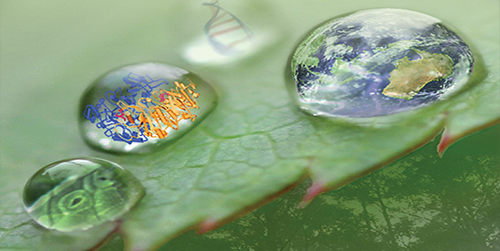A synthetic biology approach to supercharging plant CO2 fixation
Projects are availble aimed at discovering fundamental issues relating to the biogenesis and catalytic function of the CO2-fixing enzyme Rubisco.
Research themes
Project status
Content navigation
About

Projects are availble aimed at discovering fundamental issues relating to the biogenesis and catalytic function of the CO2-fixing enzyme Rubisco. The projects involve the development and use of syntheitc biology tools to manipulate Rubisco in chloroplasts, evolve (and adapt) the enzyme's kinetics in custom designed E. coli strains, as well as survey nature for improved forms of Rubisco - which we have found in a number of algae. The ultimate goal is to explore the evolutionary protein landscape of both natural Rubisco and synthetic variants evolved by directed evolution to improve crop photosynthesis and growth.
Why are we doing this? As annual genetic gains through breeding strategies and agricultural land availability begin to lag behind demand the indications are we are heading for unsustainable global populations. Compounding the problem are the uncertainties of climate change. Strategies to improve crop yield potential have begun to examine aspects of supercharging photosynthesis as a means to precipitate a new 'green revolution'. Central to many of these strategies is addressing the catalytic inadequacies of Rubisco as these have a pervasive influence on the efficiency with which plants use their resources of water, nutrients and light.
Your research can hit the ground running as we have a range of modified plants lines producing foreign, modified or greater amounts of Rubisco. These are awaiting molecular, biochemical and physiological analysis to discover fundamental issues relating to Rubisco biogenesis, its manipulation in chloroplasts and how the synthetic enzymes influence photosynthetic C-assimilation and plant growth. Coupled with this are a range of Rubisco directed evolution projects using a new, high-throughput E. coli screen tailored to identifying synthetic Rubisco enzymes with improved activity. For those wanting to explore natural catalytic diversity, my lab has an algae collection and range of plant species from extreme growth habitats (e.g. CAM, C4) whose Rubisco kinetics are awaiting characterization.
Suggested reading
- Wilson, R & Whitney, S 2017, 'Improving CO2 Fixation by Enhancing Rubisco Performance', in Miguel Alcalde (ed.), Directed Enzyme Evolution: Advances and Applications, Springer, Spain, pp. 101-126pp
- Parry, M, Andralojc, P, Scales, J, Salvucci, ME, Carmo-Silva, E, Alonso, H, Whitney, SM. 2013, 'Rubisco activity and regulation as targets for crop improvement', Journal of Experimental Botany, 64 (3):717-730
- Whitney, S, Houtz, R & Alonso, H 2011, 'Advancing our understanding and capacity to engineer nature's CO2-sequestering enzyme, Rubisco', Plant Physiology, vol. 155, 27-35.

